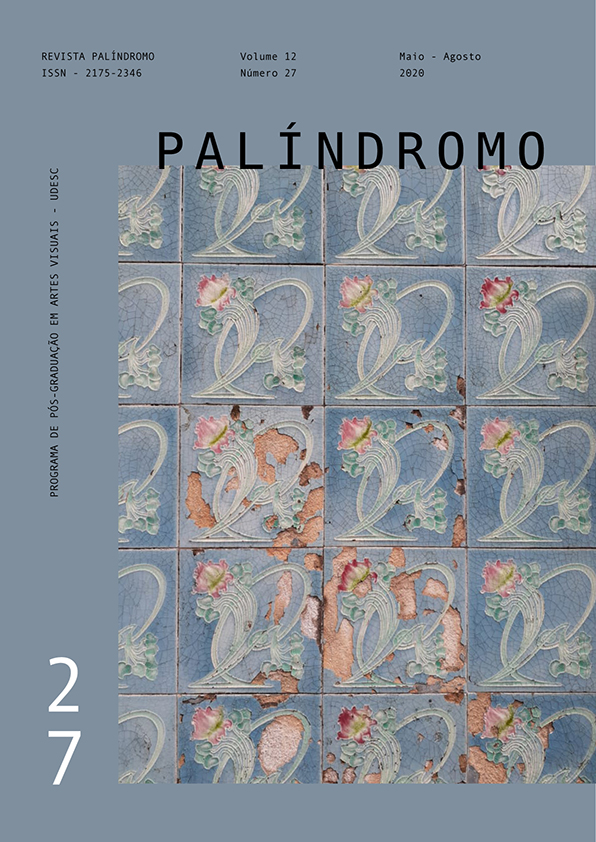Image-fiction as an action strategy for possible worlds
DOI:
https://doi.org/10.5965/2175234612272020199Keywords:
possible worlds, image-fiction, fingere, contemporary art, image theoryAbstract
In this article, an application of the theories of possible worlds in the study of the image and its effects is proposed. After a brief introduction to this theoretical universe, we move on to the context of visual arts, in which there are not many published works on the subject. A notion of “ways of worldmaking” is developed, which emerges from an active image-fiction, established by the “fingere” of the artist. The attitude of self-denunciation of this image allows the viewer to find evidence of its manipulated quality, which ultimately allows for a cognitive change in relation to the constructions and changes that we can make in our so-called real world. After a case study, it is concluded that, like the image, reality is a manipulable matter, and the understanding of this opens up paths for the construction of new contexts in the present.
Downloads
References
BOILLAT, A. Cinéma, machine à mondes: essai sur les films à univers multiples. Chê-ne-Bourg: Georg, 2014.
CARVALHO, J. D. Artes e mundos possíveis. Aisthe, v. 6, n. 10, p. 120–137, 12 out. 2012.
DOLEŽEL, L. Heterocosmica: Fiction and Possible Worlds. Baltimore: Johns Hopkins Universi-ty Press, 1998.
DUBOIS, P. De l’image-trace à l’image-fiction. Le mouvement des théories de la pho-tographie de 1980 à nos jours. Études photographiques, n. 34, 4 jun. 2016.
FROGIER, L.; Parc de la Villette. Li Wei. Arles/Paris: Actes Sud, Parc de la Villette, 2012. Catálogo de exposição, 20 mars-19 août 2012.
GOODMAN, N. Manières de faire des mondes. Paris: Gallimard, 2006.
GUELTON, B. Archifiction: quelques rapports entre les arts visuels et la fiction. Paris: Publications de la Sorbonne, 2007.
KRIPKE, S. Semantical considerations on Modal Logic. In: LINSKY, Leonard (Ed.). Re-ference and Modality. Oxford: Oxford University Press, 1979, p. 63–72.
KRIPKE, S. La logique des noms propres. Paris: Éd. de Minuit, 1982.
LAVOCAT, F. Fait et fiction: pour une frontière. Paris: Seuil, 2016.
LAVOCAT, F. (Org.). La théorie littéraire des mondes possibles. Paris: CNRS, 2010.
LEIBNIZ, G. W. Essais de théodicée: sur la bonté de Dieu, la liberté de l’homme et l’origine du mal. Paris: Flammarion, 1969.
LINDE, U. Image and Dimension. In: ALLÉN, S. (Org.). Possible Worlds in Humanities, Arts and Sciences: Proceedings of Nobel Symposium 65. Berlin; New York: De Gruyter, 1989, p. 312–318.
OWENS, C. Beyond Recognition: Representation, Power, and Culture. Berkeley: Uni-versity of California Press, 1992.
PAVEL, T. Possible Worlds in Literary Semantics. The Journal of Aesthetics and Art Criticism, v. 34, n. 2, p. 165–176, 1975.
PAVEL, T. Univers de la fiction. Paris: Seuil, 1988.
RYAN, M.-L. Possible Worlds, Artificial Intelligence, and Narrative Theory. Blooming-ton: Indiana University Press, 1991.SCHAEFFER, J.-M. Pourquoi la fiction? Paris: Seuil, 1999.
SCHMUTZ, J. Qui a inventé les mondes possibles? In: BARDOUT, Jean-Christophe; JULLIEN, Vincent (Eds.). Les mondes possibles. Cahiers de philosophie de l’Université de Caen. Caen: Presses Univ. de Caen, 2006, p. 9–38.
SOURIAU, É. La correspondance des arts: éléments d’esthétique comparée. Paris: Flammarion, 1969.
Downloads
Published
How to Cite
Issue
Section
License
Copyright (c) 2020 Palíndromo

This work is licensed under a Creative Commons Attribution 4.0 International License.
COPYRIGHT STATEMENT
The articles published by the magazine are free to use, intended for academic and non-commercial applications. Copyright is all assigned to the magazine. The articles whose authors are identified represent the expression from the point of view of their authors and not the official position of Palíndromo Magazine. The author (s) commits to whenever they publish material referring to the article published in Palíndromo mention this publication as follows:
This article was originally published by Palíndromo magazine in its volume (place the volume), number (place the number) in the year of (place the year) and can be accessed at: http://www.revistas.udesc.br/index.php/palindromo


